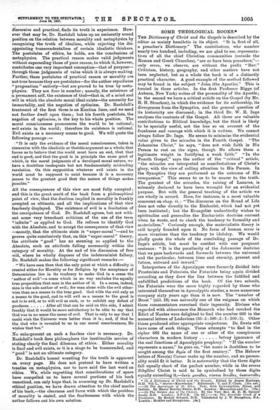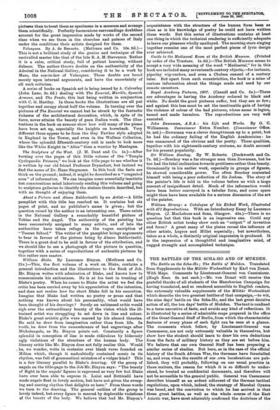SOME THEOLOGICAL BOOKS.*
THE Dictionary of Christ and the Gospels is described by the editor as mainly homiletic in its object. "It is, first of all, a preacher's Dictionary." The contributors, who number nearly two hundred, including, we are glad to see, representa- tives of- all the chief Christian communities (outside the Roman and Greek Churches), "are or have been preachers,"— only seven, we observe, are without the prefix "Rev." Criticism, history, geography, and other matters have not been neglected, but as a whole the book is of is distinctly practical character. A good example of the method followed may be found in the subject "John (the Apostle)." This is treated in three articles. In the first Professor Riggs (of Auburn, New York) writes of the personality of the Apostle; in the second we have a critical article on the Gospel (by Mr. R. H. Strachan), in which the evidence for its authorship, its divergences from the Synoptics, and the general question of its historicity are discussed; in the third Dr. W. R. Inge analyses the contents of the Gospel. All three are valuable contributions to Biblical knowledge, but the third is likely to be specially useful, not the less so on account of the frankness and courage with which it is written. We cannot always follow Dr. Inge. He seems to minimise the evidential value given to the miracles in the Fourth Gospel. "The Johannine Christ," he says, "does not wish • faith in His Person to rest on the signs, though He allows them a legitimate weight in fortifying a weak faith." "In the Fourth Gospel," says the author of the "critical" article, "the miracles are interpreted as manifestations of Christ's glory, with the view of calling attention to His Person. In the Synoptics they are performed as the outcome of His compassion." This seems to us to be nearer to the truth. The greatest of the miracles, the raising of Lazarus, is solemnly declared to have been wrought for an evidential purpose. But with the general teaching of the article we are wholly in accord. Here, for instance, is a most valuable comment on chap. vi. : "The discourse on the Bread of Life does not refer directly to the Eucharist, which had not yet been instituted ; but the Evangelist undoubtedly wishes. to spiritualise and generalise the Eucharistic doctrine current when Ile wrote, and to check the tendency to formality and materialism." Curiously enough, the materialistic theory is Still largely founded upon it. No form of human error is more vivacious than the tendency to idolatry., We would gladly quote the whole of the concluding passage of Dr. Ing,e's article, but must be conant with one pregnant sentence: "It is the peculiarity of the Johannine doctrine that we pass backwards and forwards between the universal and the particular, between time and eternity, present and future, outward and inward."
Interpreters of the Apocalypse were formerly divided into Praeterists and Futurists, the Futurists being again divided according as they drew the line between the fulfilled and unfulfilled predictions of the book. Of the two schools, the Futurists were the more highly regarded by those who interested themselves in Apocalyptic studies, a more numerous company sixty years ago than it is now. The "number of Beast" (xiii. 18) was naturally one of the enigmas on which these commentators exercised their ingenuity. Divines who regarded with abhorrence the Monarch who had revoked the Edict of Nantes were delighted to find the number 666 in the numeral letters of Ludovicus (50: 5 500 :5 : 1 : 100 :5). Other times produced other appropriate conjectures. Dr. Swete will have none of such things. These attempts "to find in the cipher 666 the name of one or other of the conspicuous characters in modern history betray ignorance Of the real functions of Apocalyptic prophecy." "If the number represents a name," he goes on, "the name is doubtless to be sought among the Ospla of the first century." The Hebrew letters of Nero(n) Caesar make up the number, and no person- ality could fit it better. It is noteworthy that the three digits fall equally Short of the perfect number, while in the versus Sibyllini Christ is said to be symbolised by three digits equally exceeding it,—Own', poinitier, vOcwrat tiestitier, licarovreibee 11) A Dictionary of Christ and the Gospel.. Edited by James Hastings D.D. Vol. I., •' Aaron—Knowledge." Edinbargh T. and T. Clark. [21s. neti —(2) Th. Apocalypse of St. John. rest, wall Introduction. Notes. an Indices. By Henry Barclay Swat., D.D. London Macmillan and Co. [15.] —(S) The Golden Age of the Church. By the Very Bev: Ii. 0. M. Spence. Jones, D.D. London :f7s. ed.]—(4 The boientlfie Crud of a 'Theologian. By Rudolf Schmid, D.D. Translated by J. W. Stoughton, 13.4. London : Hodder and Stoughton. 103.1
pictures than to treat them as specimens in a museum and arrange them scientifically. Perfectly harmonious surroundings doubtless account for the great impression made by works of the second class when we see them in the churches and palaces of Italy under the conditions their artists designed for them.

















































 Previous page
Previous page